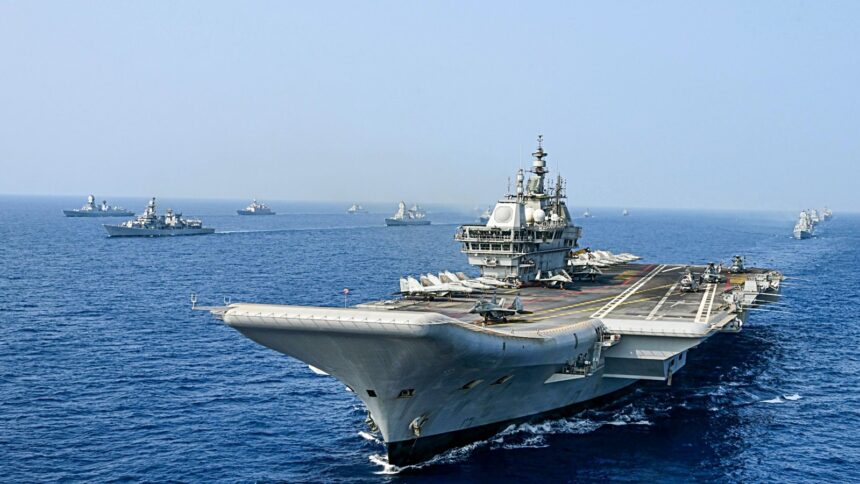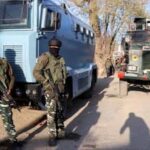Two days after they decided to end military action against each other following Operation Sindoor, the Director Generals of Military Operations (DGMOs) of India and Pakistan Monday “agreed that both sides consider immediate measures to ensure troop reduction from the borders and forward areas”.
DGMO Lt General Rajiv Ghai spoke to his Pakistani counterpart Major General Kashif Abdullah at 5 pm Monday — their second conversation since Saturday when they agreed to stop all military actions.
The Indian Army said: “Issues related to continuing the commitment that both sides must not fire a single shot or initiate any aggressive and inimical action against each other were discussed. It was also agreed that both sides consider immediate measures to ensure troop reduction from the borders and forward areas.”
Earlier in the day, releasing more visual evidence of the damage inflicted on 13 Pakistani military installations in retaliatory attacks, the Indian Armed Forces said that a multi-layered counter-drone and air defence grid successfully foiled Pakistani attempts to hit multiple military installations and civil infrastructure last week.
Briefing the media on Operation Sindoor, Lt General Ghai and his Indian Air Force and Navy counterparts, Air Marshal A K Bharti and Vice Admiral A N Pramod, said Pakistan used a range of weapons – from Chinese-origin missiles and Turkish-origin drones to armed UAVs and loitering munitions – in its attempt to reach targets in India.
Drawing a cricket analogy to explain the multi-layered, robust, integrated air defence systems in place, Lt General Ghai said, “Targeting our airfields and logistics is way too tough… I saw that has just retired from Test cricket. He is one of my favourites… In the 1970s, during the Ashes between Australia and England, two Australian bowlers destroyed the batting line-up of England, and then Australia gave a proverb: ‘Ashes to ashes, dust to dust, if Thommo don’t get ya, Lillee must’. If you see the layers, you will understand what I am trying to say. Even if you cross all the layers, one of the layers of this grid system will hit you.”
Air Marshal Bharti said tri-service assets were deployed in a multi-layered system – point defence comprised low-level air defence guns and shoulder-fired weapons, while aerial defence comprised fighter aircraft and long-range missiles. A range of surveillance radars also formed part of the grid.
Lt Gen Ghai said repeated attempts by Pakistan to target Indian airfields and logistic installations on May 9 and 10 were unsuccessful because of the robust air defence grid.
He said the first layer comprised counter-drone systems and MANPADS (Man-Portable Air Defence Systems), the second and third layer of the grid comprised point air defence, short-range surface-to-air missiles and medium-range surface-to-air missiles respectively. The fourth layer of the grid comprised long-range surface-to-air missiles.
According to Air Marshal Bharti, this complex counter-drone and air defence shield countered a range of Pakistani threats such as Chinese-origin PL-15 air-to-air missiles, Turkish-origin Yiha systems, aside from other missiles, long-range rockets, loiter munitions and a range of quadcopters typically used for surveillance.
He said the numerous waves of drones and UCAVs used by Pakistan were also thwarted by indigenously developed soft and hard-kill counter-UAS systems and well-trained AD personnel. “All this was brought together as an efficient and effective AD environment, by the Integrated Air Command & Control System (IACCS) of the lAF, which accords us Net-Centric Op capability,” he said.
He said older and battle-proven AD weapons like the Pechora, OSA-AK and the LLAD guns played a key role in countering the Pakistani threat vectors in the current operations and underlined the “stellar performance” of indigenous AD weapons like the Akash system.
In spite of some minor damage incurred, he said, all Indian military bases and systems continue to remain fully operational, and ready to undertake further missions if needed.
He displayed video evidence of damage caused by Indian precision strikes at the Nur Khan airbase and Rahim Yar Khan airbase in Pakistan – one showed a huge crater at Rahim Yar Khan. As many as 13 military targets, from Rawalpindi to Karachi, were struck in retaliatory precision strikes.
He said the Kirana hills, near Pakistan’s Sargodha air base, were not hit by India – the hills are said to house a nuclear facility.
Vice Admiral Pramod said the Navy was effectively using multiple sensors and inputs. “We are maintaining continuous surveillance to degrade or neutralise threats as they emerge or manifest, to ensure targeting at extended ranges.”
“All these are conducted under the umbrella of a comprehensive and effective layered Fleet Air Defence mechanism that caters for all threats, be it drones or high speed missiles or aircraft, both fighters as well as surveillance aircraft,” he said.
He said the fleet operates as a composite force, maintaining a surveillance bubble at extended ranges using advanced radars.
“Any aerial target that attempts to penetrate this bubble is detected and identified using various techniques and technologies, affording quick and clear distinction between commercial, neutral and hostile aircraft or flying objects at ranges above the anticipated attack range,” he said.
The Carrier Battle Group with its integral Air Wing provides the first layer of this layered mechanism, he said, highlighting that adequately equipped and trained naval pilots are able to operate both by day and night.
“In the current standoff, the presence of our aircraft carrier with a large number of Mig-29K fighters and airborne early warning helicopters prevented any suspicious or hostile aircraft close to the Carrier Battle Group within several hundred kilometres,” he said.
The CBG, with formidable offensive capability, was able to operate with impunity and maintained an uncontested presence in the area of operations, he said.
“Effectively, it compelled the Pakistani air elements to remain bottled up close to the Makran coast, denying any opportunity to be a threat in maritime space,” he said.








